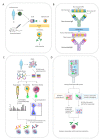Development of Therapeutic Monoclonal Antibodies for Emerging Arbovirus Infections
- PMID: 38005854
- PMCID: PMC10675117
- DOI: 10.3390/v15112177
Development of Therapeutic Monoclonal Antibodies for Emerging Arbovirus Infections
Abstract
Antibody-based passive immunotherapy has been used effectively in the treatment and prophylaxis of infectious diseases. Outbreaks of emerging viral infections from arthropod-borne viruses (arboviruses) represent a global public health problem due to their rapid spread, urging measures and the treatment of infected individuals to combat them. Preparedness in advances in developing antivirals and relevant epidemiological studies protect us from damage and losses. Immunotherapy based on monoclonal antibodies (mAbs) has been shown to be very specific in combating infectious diseases and various other illnesses. Recent advances in mAb discovery techniques have allowed the development and approval of a wide number of therapeutic mAbs. This review focuses on the technological approaches available to select neutralizing mAbs for emerging arbovirus infections and the next-generation strategies to obtain highly effective and potent mAbs. The characteristics of mAbs developed as prophylactic and therapeutic antiviral agents for dengue, Zika, chikungunya, West Nile and tick-borne encephalitis virus are presented, as well as the protective effect demonstrated in animal model studies.
Keywords: alphavirus; antibody discovery; arbovirus; flavivirus; monoclonal antibody; neutralizing antibody.
Conflict of interest statement
The authors declare no conflict of interest.
Figures


Similar articles
-
Factors contributing to and strategies to combat emerging arboviruses.Glob Public Health. 2018 Dec;13(12):1846-1852. doi: 10.1080/17441692.2018.1464588. Epub 2018 Apr 17. Glob Public Health. 2018. PMID: 29663859
-
Possible future monoclonal antibody (mAb)-based therapy against arbovirus infections.Biomed Res Int. 2013;2013:838491. doi: 10.1155/2013/838491. Epub 2013 Aug 22. Biomed Res Int. 2013. PMID: 24058915 Free PMC article. Review.
-
Ocular manifestations of emerging arboviruses: Dengue fever, Chikungunya, Zika virus, West Nile virus, and yellow fever.J Fr Ophtalmol. 2018 Jun;41(6):e235-e243. doi: 10.1016/j.jfo.2018.05.002. Epub 2018 Jun 19. J Fr Ophtalmol. 2018. PMID: 29929827 Review.
-
Isatin Derivatives and Their Antiviral Properties Against Arboviruses: A Review.Mini Rev Med Chem. 2019;19(1):56-62. doi: 10.2174/1389557518666180424093305. Mini Rev Med Chem. 2019. PMID: 29692243 Review.
-
Co-protoporphyrin IX and Sn-protoporphyrin IX inactivate Zika, Chikungunya and other arboviruses by targeting the viral envelope.Sci Rep. 2018 Jun 28;8(1):9805. doi: 10.1038/s41598-018-27855-7. Sci Rep. 2018. PMID: 29955082 Free PMC article.
Cited by
-
Insect-specific virus platforms for arbovirus vaccine development.Front Immunol. 2025 Mar 14;16:1521104. doi: 10.3389/fimmu.2025.1521104. eCollection 2025. Front Immunol. 2025. PMID: 40160816 Free PMC article. Review.
-
Tixagevimab/cilgavimab or placebo for COVID-19 in ACTIV-2: Safety, pharmacokinetics and neutralizing and anti-drug antibodies.iScience. 2025 Feb 4;28(3):111938. doi: 10.1016/j.isci.2025.111938. eCollection 2025 Mar 21. iScience. 2025. PMID: 40124489 Free PMC article.
-
Zika virus: an overview update.Curr Opin HIV AIDS. 2025 May 1;20(3):294-302. doi: 10.1097/COH.0000000000000926. Epub 2025 Mar 17. Curr Opin HIV AIDS. 2025. PMID: 40048580 Free PMC article. Review.
-
Potent Cross-neutralizing Antibodies Reveal Vulnerabilities of Henipavirus Fusion Glycoprotein.Adv Sci (Weinh). 2025 Jul;12(27):e2501996. doi: 10.1002/advs.202501996. Epub 2025 Apr 29. Adv Sci (Weinh). 2025. PMID: 40298900 Free PMC article.
-
Zika virus vaccines and monoclonal antibodies: a priority agenda for research and development.Lancet Infect Dis. 2025 Jul;25(7):e402-e415. doi: 10.1016/S1473-3099(24)00750-3. Epub 2025 Feb 27. Lancet Infect Dis. 2025. PMID: 40024262 Free PMC article. Review.
References
Publication types
MeSH terms
Substances
LinkOut - more resources
Full Text Sources
Medical

